How to Spend a Magical 3 Days in Seville
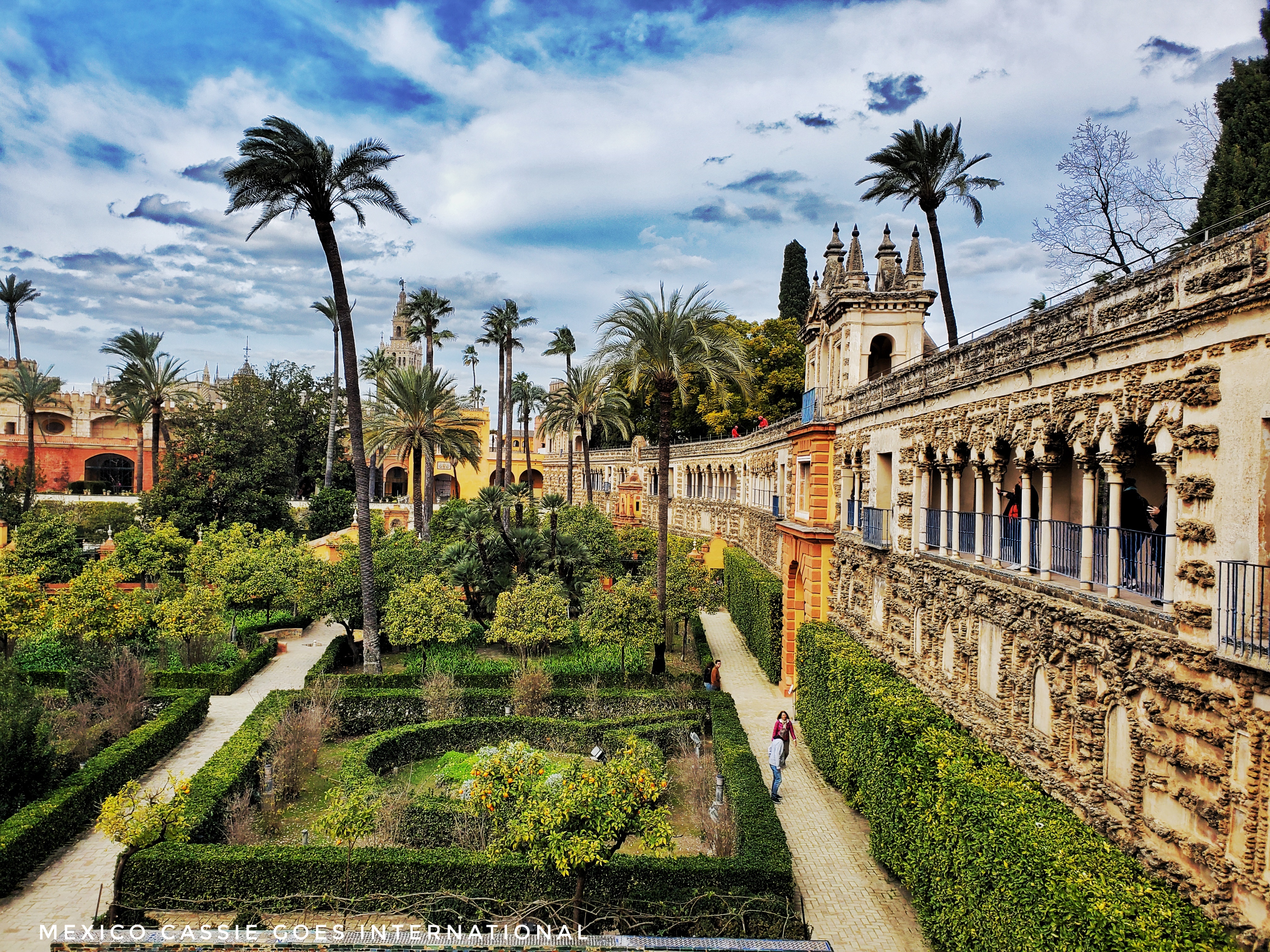
You’ll be happy to know that 3 days in Seville, the incredible capital city of Andalucía, is actually plenty of time to see the best things Seville has to offer.
The beauty of Seville comes not only in the gorgeous and impressive buildings and its long history but also in the fact that the city is fairly small. It’s easy enough to walk between tourist attractions.
Seville is a perfect destination for a short city break, as part of a longer road trip around southern Spain or as a side trip from the incredible capital city of Madrid.
There are affiliate links in this article. If you click and make a purchase I could make a small sum at zero cost to you. Thank you!
If you have longer than 3 days, check out this ideal 5-day itinerary for Seville. It includes an awesome day of exploring Seville’s quirky side. And if you are only in town for 1 day, we have a perfect 1 day itinerary for Seville too. If you’re still trying to decide how many days you need in Seville, that’s ok too.
3 days in Seville itinerary notes
📌 In the 3 days in Seville itinerary outlined below you’ll find I suggest one morning activity, an afternoon activity, and an evening activity.
🔆 Seville’s climate and siesta culture both, of course, need to be taken into account when planning a trip. It is always worth checking the opening hours for the places you want to visit as there is little conformity between attractions and even between seasons. Many places will close during the afternoon and then reopen in the evening.
🍽 Meal times: In Andalucia, the biggest meal of the day is lunch, which is taken between 2 pm – 4 pm. In Seville, you’ll always be able to find somewhere to eat something but between 4 pm – 8 pm many bars and restaurants will be closed so you’ll need to be flexible. People start coming out again to eat around 9 pm and it’s perfectly normal to see groups eating at 11 pm.
🎟 Seville is a very popular destination for tourists and as such it is always recommended to book tickets to the main attractions in advance. If you don’t, you risk missing out or spending a long time waiting in line for the potential of a last minute ticket.
🛝 If you’re coming to Seville with kids then this article will still come in handy but I highly recommend you also read my articles dedicated to finding the fun for kids in Seville and in Andalucía as they do offer far more specific kids friendly activities. There are also some activities that will be perfect for anyone visiting with teens.
⭐️ If you’re unsure as to whether you should visit Malaga or Seville, or Valencia or Seville, it’s worth doing some reading (including my articles, obv) to figure out which is more fitting for your vacation needs.
🏨 Where to stay in Sevilla
⭐️ The MexicoCassie top recommended hotel is: Hotel Las Casas de la Judería – this is a fabulous boutique hotel, comprising 27 traditional houses connected by gorgeous patios and winding passage ways. You’ll never have seen anything like it. Add the rooftop terrace and pool to this combination and you have your winner!
⭐️ The MexicoCassie top recommended apartment is: Feel at home San Lorenzo apartments – where you will find nicely centrally located apartments with elevator, swimming pool & free shuttle from airport
⭐️ The MexicoCassie ‘treat yourself’ recommended hotel is: Hotel Alfonso XIII – there’s simply nowhere like this in Sevilla. Located by the Alcazar, this hotel is the epitome of refined luxury, a true ‘treat yourself’ experience. If you can’t stay here, I highly recommend booking a table for Sunday brunch.
⭐️ The MexicoCassie midrange recommended hotel is: Hotel Fernando III – still well located in the Santa Cruz district, this midrange hotel offers comfortable rooms, a roof terrace with pool, a good breakfast and very helpful staff.
🗺 Or, use the MexicoCassie interactive map to find your perfect accommodation.
3 Days in Seville itinerary overview
Let’s begin with a quick overview and then below you can dive into the details.
Day one: Marvel at the grandeur of Plaza de España and take a stroll through Maria Luisa Park. After lunch learn about Seville’s Roman history in the Antiquarium, visit the Palacio de las Dueñas and in the evening, embrace modern Seville at Las Setas. End on the cool Plaza del Salvador for tapas and drinks.
Day two: Take an exclusive early morning tour of Seville’s gorgeous Alcazar before it fills up with other people. After lunch, meander through the Jewish Quarter, perhaps visiting the Hospital los Venerables or the India Archives.
Spend the evening meandering through the streets of the “Independent Republic of Triana”, to check out their long history as the glazed tile-making area. Enjoy a tapa here, a tinto de verano or an aparol spritz there…
Day three: Begin the day with a tour of the city. After lunch, visit the cathedral and finish with a tapas & flamenco tour.
Okay, so now let’s dive into the details
3 days in Seville
3 days in Seville
Day 1
Morning: Plaza de España
🧭 Av Isabel la Catolica

📌 Brief History: The Plaza de España is really the most famous and one of the most beautiful landmarks in all of Seville for both tourists and locals alike. Built in 1928 for the Ibero-American Exhibition (of 1929), this astounding semi-circular building has two high towers from which you can see much of Seville.
📌 Cool Fact: Plaza de España has been in both Star Wars II and Lawrence of Arabia. It was also in the Netflix show, The Dictator. Look out for scenes filmed in the Plaza de España in the Netflix series, Kaos.
What to Expect at Plaza de España
✅ All around the building are 48 tiled alcoves each representing a Spanish province (except for Seville which is featured elsewhere and one of the Canary Island provinces which didn’t exist in 1928). Each has a mural and a map of the province. Exploring these gorgeous alcoves is a perfect place to begin your first day in Seville.
✅ You will see four bridges in the courtyard; these represent the four ancient kingdoms of Spain: Castile, Léon, Aragon, and Navarre. The bridges traverse a 500 m-long canal and it’s possible to rent small boats and row along here. Because of this canal it’s sometimes called the Venice of Seville.
✅ Many of the buildings are government offices (including where foreigners like me go to get residency paperwork sorted) but the Military History Museum is housed there too.
What to Do Around Plaza de España
📌 Enjoy strolling around, checking out the gorgeous murals and tiles. You might even happen upon an impromptu flamenco show
📌 If you’re so inclined, hire a boat and row around the canal
📌 Climb the stairs and enjoy the views
📌 Take a stroll through Parque Maria Luisa while you’re here and if you’re into horse-drawn carriages, this is one place to pick them up. The park is around 100 acres of paths, gardens, and patios. I love spending an hour or so just relaxing here especially when green parrots fly overhead. See if you can find Monté Gurugú
➕ Bonus Activity: The Museo de Artes y Costumbres is in the park, on the other side of this park is the Archaeological Museum and if you’re visiting with kids, the Seville Aquarium is nearby.
Afternoon: Antiquarium & Palacio de las Dueñas
🧭 Plaza de la Incarnacio
Under Las Setas you’ll find this archaeological museum, which I think is an absolute hidden gem of Sevilla and I highly recommend heading in if you have any interest in the Roman history of Seville.
📌 Brief history of the Antiquarium
This is a modern, well-presented archaeological museum where you can follow paths through the ruins of Roman and Moorish Seville. The site was discovered when excavating for a carpark in 2003.
What to Expect at the Antiquarium
✅ There are eleven areas of remains including seven columned houses with mosaics, salting vats (very common in Roman ruins in this area) and streets. The best preserved is a house from the 5th century CE called Casa de la Columna
✅ Be sure to find the Medusa mosaic and the symbol of the Antiquarium, the kissing birds
✅ The River Baetica flowed nearby during the Roman period, hence the fish-salting vats
➕ Bonus: Palacio de las Dueñas – if you have time and energy this gorgeous palace (photo below) is just a five minute walk from Las Setas.
Palacio de las Dueñas
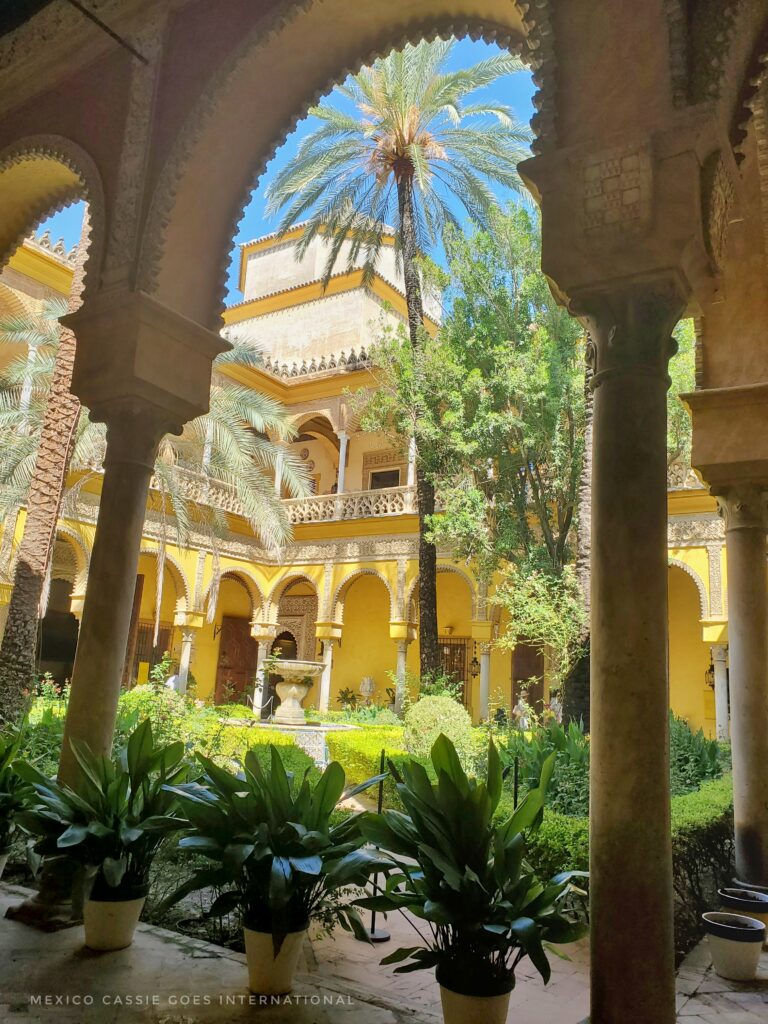
Brief history of the Palacio de las Dueñas
This palace was built between the fifteenth and sixteenth centuries and has been home to some big names in Spanish history and others and today it is a private residence belonging to the House of Alba.
What to Expect: Palacio de las Dueñas is something of a quiet gem in Sevilla. For me, the most wonderful thing about this place is its gardens and courtyards. While they’re smaller and not as showy as the Alcazar gardens, I really loved the sense of complete peace I felt while walking around this place.
Evening: Las Setas de Sevilla (Metropol Parasol) and tapas on Plaza del Salvador

I recommend not leaving this area so you can see Las Setas after dark because this is the best time to be here. If you have a while before sunset, grab a drink or go for a stroll until it’s dark and then head up to The Levels, the walkways on the top of the Las Setas structure (to do this go into the basement and join the line to buy tickets or buy in advance online)
📌 Brief History of Las Setas
“Las Setas” (The Mushrooms) is the popular name for Metropol Parasol, this fascinating wooden structure that towers over Plaza de la Encarnacion. This plaza was the city centre of old Sevilla and it has a long history dating back to the Roman period.
It was only in the early twenty-first century when the city of Seville decided to build a new plaza with underground parking here that the ancient history of this area was rediscovered. While excavating for the garage they found important ancient remains and plans for a parking lot were abandoned. Instead, the archaeological museum (mentioned above) was created and after a design competition Las Setas was built – apparently, this is the world’s largest wooden structure.
⭐️ There are a myriad of excellent reasons to visit Spain, keep reading to learn more about this magnificent country ⭐️
What to Expect at Las Setas
✅ Today when you visit Las Setas you’ll see a fascinating wooden structure that covers the raised plaza. The views of Seville are incredible from up on top, on “The Levels” and if you go in the evening you’ll experience the whole thing lit up by changing neon lights.
✅ The ground floor hosts a market that in truth I’ve never seen fully open (despite going many times at different times of day) and a couple of tapas bars. There are also tapas bars all around the edges of the plaza.
✅ The plaza itself is raised up and is popular with locals and visitors who just want to hang out for a while. Kids love to whizz themselves up and down the concrete sidings and you’ll often see groups of local kids (mine included) having an absolute blast here.
✅ When you’ve had your fill of gorgeous views and the gently changing lights, meander slowly through the narrow streets of Seville’s old town toward Plaza del Salvador to enjoy the bar scene and some of the best tapas in Seville while soaking up local culture.
3 days in Seville
Day 2
Morning: Real Alcázar de Sevilla and Gardens (Royal Palace)
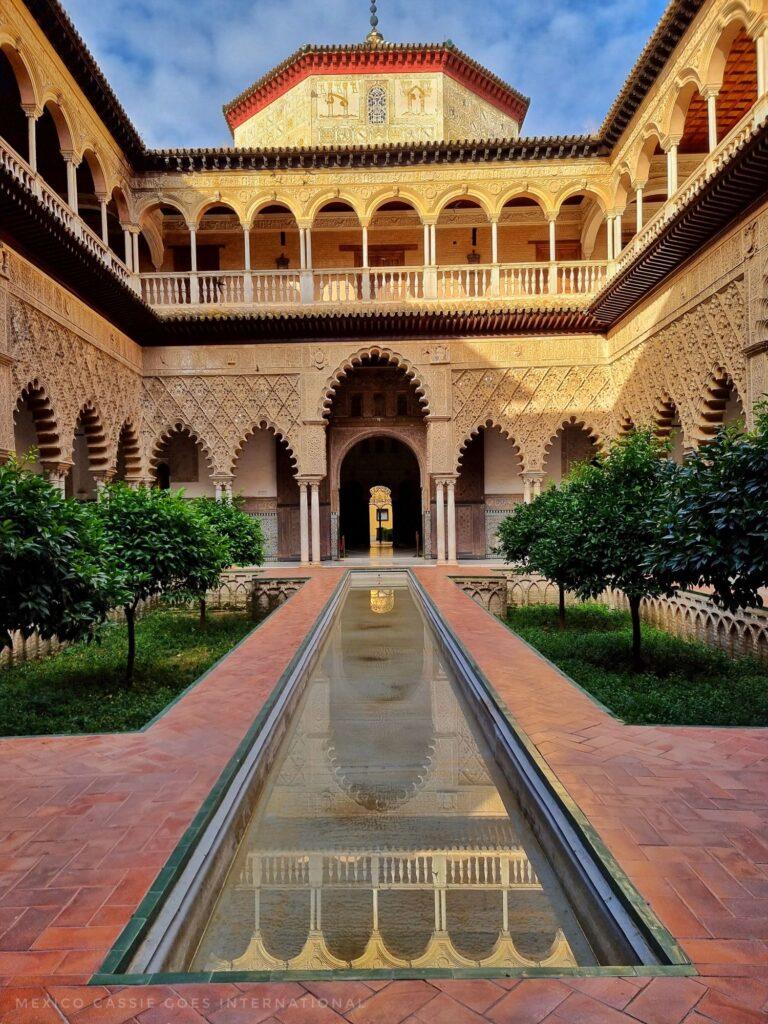
📌 Brief history of the Alcazar
The beautiful Alcazar of Seville was originally built by the Moorish rulers of Spain but was adapted and modified by the Catholic Monarchs when they conquered Seville (1248). Today it is considered one of the best examples of Mudéjar (blended Moorish and Christian) architecture in the world. Along with the cathedral and the Archivo de Indias, the Alcazar is part of the Seville UNESCO World Heritage Site.
The first fortified building on this site has been dated to the early eighth century during the Caliphate of Córdoba. In 913, Abd al-Rahman III built a fort here, apparently over the remains of a Visigoth church (the Visigoths ruled over much of Spain from the decline of the Roman Empire in Spain to the time the Moors arrived).
In the twelfth century, the Almohad rulers established their capital in Seville and built new palaces on this site. However, in 1248, Seville was taken by the Catholic Monarchs (los Reyes Catolicos) and the Alcazar became their primary residence.
😎 Cool Fact: The Alcazar was the setting for important historical moments such as the wedding of Carlos V (the first Holy Roman Emperor) and Isabella of Portugal and some of the Game of Thrones scenes were filmed here too.
How to visit the Alcazar
⭐️ My recommendation is to book onto the Exclusive Walks Early Access tour. Every day the Alcazar allows just two groups of up to 20 people to enter before it opens to the general public.
I have been part of the “general public”, one of the 7000 people that visit the Alcazar every. single. day. And I have been one of the “exclusive tour members”. I can tell you that there is simply nothing like exploring the Alcazar when it’s still peaceful and quiet.
📸 You see that photo of the Patio de Doncellas (Maidens’ Courtyard) above? I took that photo when there was no one else there. There is practically zero chance of recreating that photo once the Alcazar is open to the general public.
Important information for visiting the Real Alcazar of Seville
If you don’t want to get up early for the early access tour then you can still buy your tickets:
or
➡️ you can risk waiting until you’re in Sevilla and buying on the day at the ticket office, which is located on Plaza del Patio de Banderas.
⎆ Once you have a ticket, head towards Plaza del Triunfo and the cathedral. Turn left and join the line for entrance into the Alcazar.
🪪 If you’re hoping for a reduced ticket based on your age you will need to bring a valid ID.
➡️ Read more about visiting the Alcazar, booking tickets and timings
What to See in the Alcazar
✅ As you tour the Alcazar you won’t want to miss:
- Patio de las Doncellas – The Maiden’s Courtyard. This is the main shebang in the Alcazar. Here you’ll find the main courtyard with the reflecting pool, sunken gardens and gorgeous arches. It’ll also likely be full of other people unless you book onto the early access tour.
- Patio de Leviés – fewer people find their way to this patio where there is a less grandiose pool than on the Patio de las Doncellas. I loved it here.
- Patio de las Muñecas – Dolls Courtyard. A private courtyard in the palace – see if you can spot the dolls. I’ve only ever found 2.
- Salon de Embajadores (Ambassadors’ Hall or the Throne Room) – this is the biggest and most impressive room in the whole palace. Don’t forget to look up and see the half-orange dome, referred to as the Mudejar version of the Sistine Chapel.
- Salon de los Tapices – Tapestry Room
- Tile Exhibition
- Baños de Doña Maria de Padilla – a striking underground crypt filled with water.
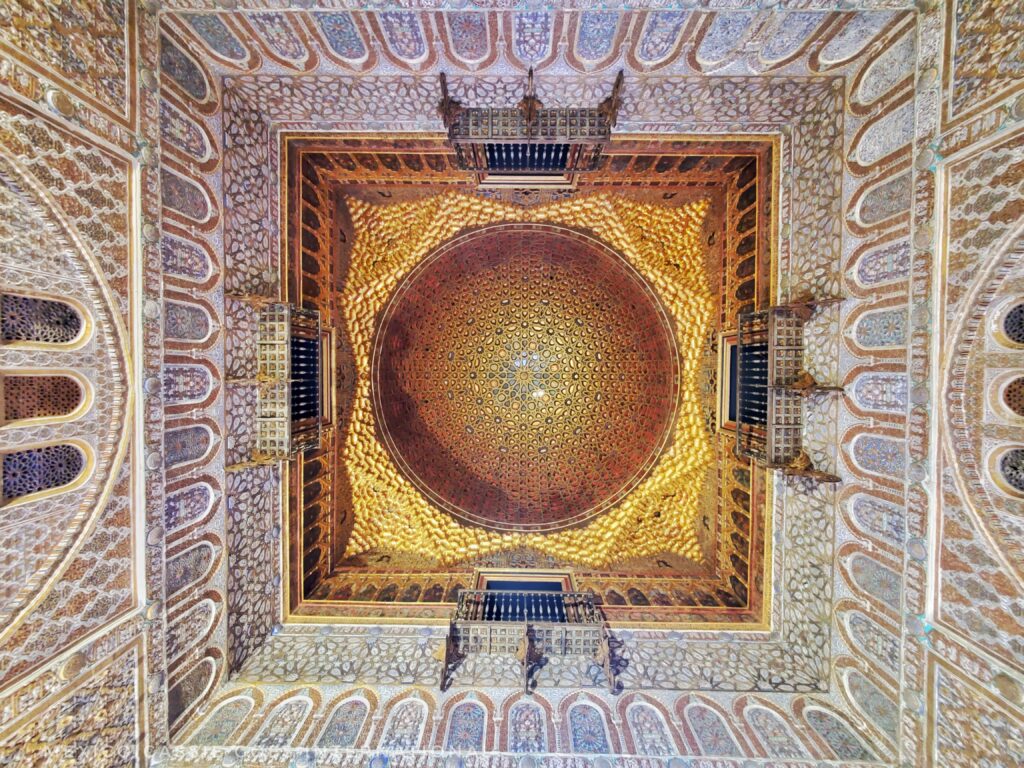
✅ The Gardens – for me, the gardens were more interesting than the palace but that’s entirely because I don’t adore intricate and fussy architecture but I do love trees and plants. But do leave yourself time to visit the gardens because they are beautiful. And if you can, climb the stairs up to the Galleria de Grutesco for gorgeous views over the gardens (the first photo in this article).
➕ Bonus: When walking to the Alcazar be sure to walk along Calle de Agua and Calle de la Judería, both gorgeous little streets.
Afternoon & evening
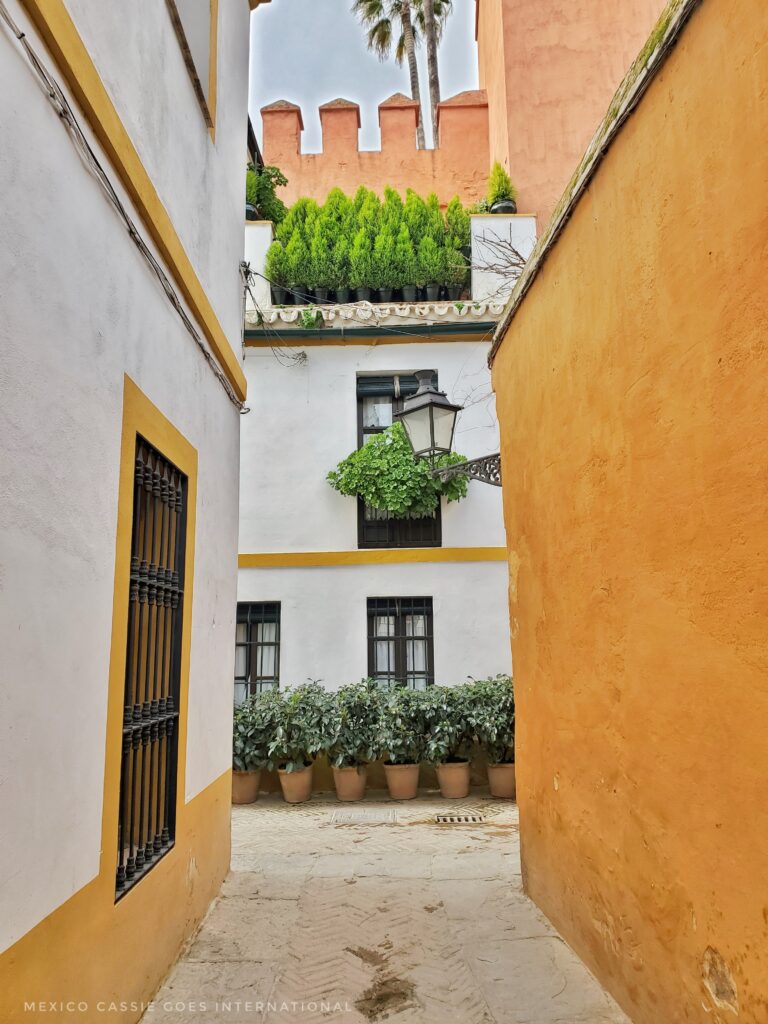
After leaving the Alcazar, take your time strolling through the Jewish Quarter (also known as Barrio Santa Cruz). Enjoy the narrow streets, the and stop at one of the many tapas restaurants for a bite to eat.
After enjoying your lunch, walk down to the river and the Torre del Oro.
Torre del Oro
This is a thirty-six metre high, dodecagonal (twelve-sided) military tower built during the Almohad Caliphate to control the Guadalquivir River during the 13th century. It was later used as a prison and today it houses the maritime museum. If you visit be sure to head up to the roof for gorgeous views along the river. Buy your ticket now.
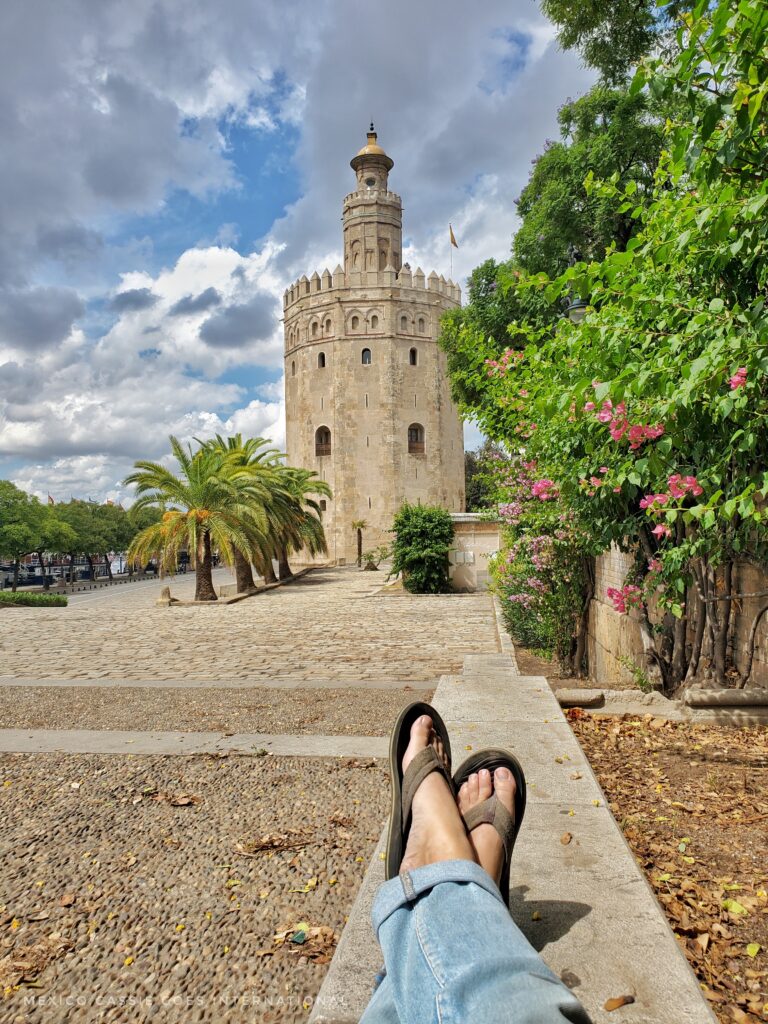
Independent Republic of Triana
Spend the late afternoon meandering through the streets of the “Independent Republic of Triana”, to check out their long history as the glazed tile-making area. Enjoy a tapa or 6 here, a tinto de verano or an aparol spritz there…

What to expect in Triana:
✅ Triana is a neighbourhood of Seville on the other bank of the river. These days it is considered to be the cool part of Sevilla. Traditionally a working-class neighbourhood (sometimes known as the Independent Republic of Triana), today there is a buzz about this place and visitors to Seville are starting to head over the bridge to check out the Mercado de Triana (the local market), the glazed tiles (azulejos) and ceramics, and the fun bar lined streets.
✅ If you’re going to visit the market please be sure to get there in the morning as by 1 pm you may well find stalls closing up for the day. If you do want to see the market, maybe make time first thing on your final day.
✅ The last remaining authentic ceramics workshops in Seville are found in the Triana neighborhood.
✅ Centro Ceramica Triana – just behind the market you’ll find this good and non-touristy museum. Around here you’ll also find great shops for picking up a souvenir or two. It feels a lot less toruisty to buy here than in centro Sevilla.
➕ Bonus: Take class while you’re in Triana. Most people choose either a Market and Tapas Class or a ceramic or tile-making class.
➕ Bonus: Sadly, at time of writing the Museo del Inquisicion was closed but I’m hopeful it’ll open its doors again
3 days in Seville
Day 3
Morning: City tour
Begin your day with a tour of the city! Choose from a free walking tour, a more in-depth guided tour, bike tours, segway tours, and even paddle boarding tours.
Top Seville tour options
📌 Hop on Hop Off Bus – you have 48 hours to enjoy using this bus that drives around Seville taking in all the biggest attractions
📌 3 hr bike Tour through the old streets of Seville with a friendly and knowledgeable English-speaking guide (Electric-bike tours are available too)
📌 Paddle board or kayak along the Guadalquivir River with a guide (I haven’t taken these tours but I have been paddle boarding in Seville and it’s a lot of fun)
📌 Self-guided audioguide tour – I’m a bit of a fan of these self-guided tours. I can listen whenever I like and at my own speed. I sometimes even use them as audiobooks on long journeys. I don’t think that’s weird, I think that’s smart.
📌 Take a cooking class if you’re more interested in tapas than sights.
Afternoon – Cathedral and La Giralda
Use this final afternoon to visit Seville’s beautiful cathedral, part of the trio that makes up the Seville UNESCO World Heritage Site (along with the Alcazar and the India Archives).
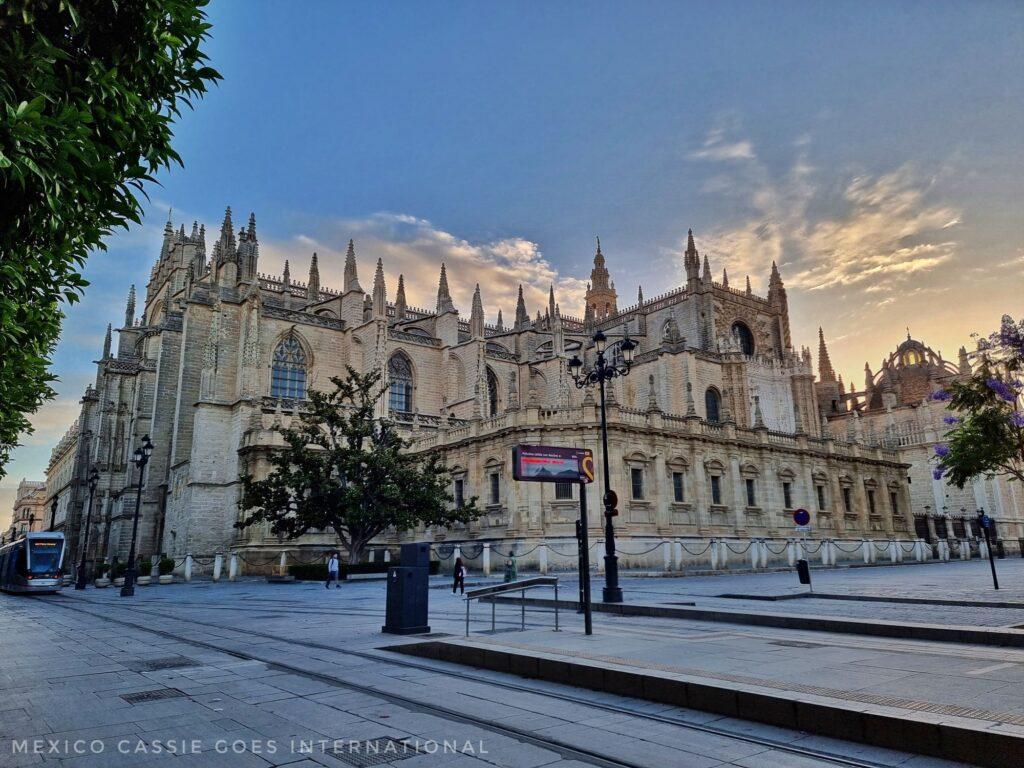
📌 Brief history of the cathedral
This cathedral was designated a UNESCO World Heritage Site in 1987. It is the largest Gothic cathedral in the world and well worth your time (although my son, who went on a school trip recently would vehemently disagree!).
Much like Córdoba’s famous Mezquita, this cathedral began life as a mosque. It was converted into a cathedral after the Christians took Seville. The cathedral we see today was completed in 1506. There are many famous artworks to be spotted while exploring the cathedral including works by Goya and Murrillo. Look out for Christopher Columbus’ extravagant resting place here too.
Did you know? The Giralda tower is not ascended with steps but instead with ramps. There are thirty-five ramps that are all wide enough for the Sultan to ride a horse to the top!! The views are as magnificent as you might imagine.
📌 You can even book a virtual tour around the cathedral from the comfort of your own home!
Evening: Flamenco time

Did you know that flamenco originates in Andalucia? Although it is pretty much synonymous with Spain and Spanish culture it’s actually a dance/musical form that originated with the Roma, influenced by Moorish tradition. There are over fifty different palos (styles) of flamenco dance. During the period of the Inquisition when Jews and Muslims were forced to convert or face expulsion or death, life was obviously extremely hard. During this time the musical cultures of Muslims, Jews and the Roma began to form the basics of flamenco. Many flamenco songs still reflect the spirit of desperation, struggle and pride of the people of this era.
⭐️ If you’re looking for the perfect flamenco experience, then a Devour Tapas & Flamenco evening tour could be exactly what you’re looking for. The tour visits 2 tapas bars where you’ll try 8 different tapas plates (enough for a full meal) and drinks. You learn all about flamenco prior to watching a fabulous performance.
I was invited by Devour Tours to take this tour and I have to be honest and say that before I took it, I was fairly ambivalent about flamenco. Now, having witnessed a truly excellent show, and learned about the dance and the traditions within it, I can’t wait to go to more shows and learn more. I fell in love.
How to get to Seville and around Seville
✈️ The Seville airport is located 10 km outside the city. There is a dedicated bus service between the airport and the city. It is well serviced by cabs (including uber).
🚆 Seville’s train station is called Santa Justa and like everything else in the city, it’s pretty centrally located. It’s a quick ride from Madrid to Seville. Both Cordoba and Cadiz are a single train ride from Seville. Check train timetables here.
🚌 Plaza de las Armas and Prado de San Sebastian are the two bus stations in Seville. Buses cover the country and also go to Tavira, Faro and further afield in Portugal. Check bus times and prices here.
🚗 I find driving in Seville perfectly fine and of course, if you’re going to take day trips then renting a car is a great idea.
The main attractions of Seville are pretty much all within walking distance of each other so for anyone who is reasonably fit it’s easy enough to get around without relying on public transport.
Of course, if you have more than 3 days in Seville you could spread this itinerary out over a few days or you could arrange a day trip or two from Seville.
📌 Ronda – see the ancient city that spans two sides of the Tajo gorge. Recommended with kids too
📌 Granada – visit the gorgeous Alhambra and explore the ancient neighbourhoods of the city
📌 Cadiz – explore one of the oldest cities in Europe and enjoy a break on the beach
📌 Aracena – visit some of the largest caves in Europe, eat great food and marvel at the castle towering above the city
📌 Antequera – visit the dolmens (neolithic burial ground) and walk in the torcal de Antequara
📌 Cordoba – visit the world famous Mezquita and enjoy the gorgeous city
📌 Gibraltar – a little slice of Britain on the edge of Spain
📌 Tarifa – not only wonderful for kitesurfing but also if you’re interested in history, nature and taking a trip to Morocco
When is the best time to visit Seville?
🌸 Spring – The climate is delightful at this time of year. The orange trees and the jacaranda trees are in blossom and in my opinion, this is the most perfect time to be in Seville due to the beauty that is these trees. If you enjoy processions and parties then spring is also a good time to visit as you’ll be able to experience the Semana Santa (holy week) parades. Seville’s Feria is also held in spring every year. In 2024 it is set for 14 – 20 April.
☀️ Summer – Truthfully, calling Seville hot is an understatement. During the summer it can feel as if you’re melting if you’re on the streets between 10 am – 10 pm. If you do come in summer, be prepared to take it slow and use my guide to Seville in the summer to help you figure out how best to explore.
Many locals leave in summer, and for good reason. If you’re coming to Southern Spain in summer, why not try adding a day or two in a a small inland village like Mijas Pueblo, or Antequera or go down to the Cádiz coast where it’ll be more comfortable?
🍁 Autumn – As the days cool down Seville starts to get lively again and you can have a great time exploring this beautiful city. In 2024, Seville’s ‘Noche en Blanco’ will return with free evening activities spread across the city.
🧤 Winter – Winters in Seville are surprisingly damp and cold although if you’re out walking and exploring all day then this really won’t matter too much, Generally, there is very little rain and plenty of sunshine even in the winter months.

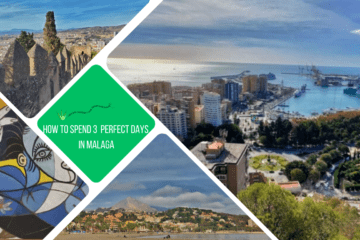
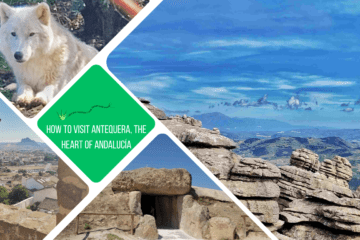
0 Comments